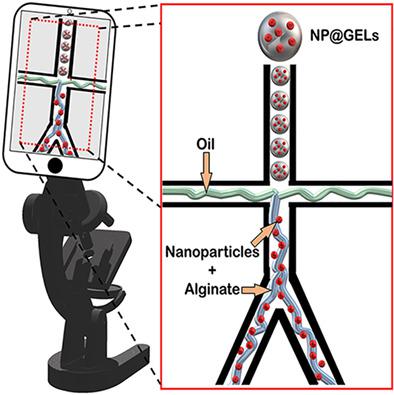当前位置:
X-MOL 学术
›
Biopolymers
›
论文详情
Our official English website, www.x-mol.net, welcomes your feedback! (Note: you will need to create a separate account there.)
Microfluidic encapsulation of nanoparticles in alginate microgels gelled via competitive ligand exchange crosslinking
Biopolymers ( IF 2.9 ) Pub Date : 2021-05-13 , DOI: 10.1002/bip.23432 Victor Dal Posolo Cinel 1 , Thiago Bezerra Taketa 2 , Bruna Gregatti de Carvalho 2 , Lucimara Gaziola de la Torre 2 , Lucas Rodrigues de Mello 1 , Emerson Rodrigo da Silva 1 , Sang Won Han 1
Biopolymers ( IF 2.9 ) Pub Date : 2021-05-13 , DOI: 10.1002/bip.23432 Victor Dal Posolo Cinel 1 , Thiago Bezerra Taketa 2 , Bruna Gregatti de Carvalho 2 , Lucimara Gaziola de la Torre 2 , Lucas Rodrigues de Mello 1 , Emerson Rodrigo da Silva 1 , Sang Won Han 1
Affiliation

|
Efficient delivery of nanometric vectors complexed with nanoparticles at a target tissue without spreading to other tissues is one of the main challenges in gene therapy. One means to overcome this problem is to confine such vectors within microgels that can be placed in a target tissue to be released slowly and locally. Herein, a conventional optical microscope coupled to a common smartphone was employed to monitor the microfluidic production of monodisperse alginate microgels containing nanoparticles as a model for the encapsulation of vectors. Alginate microgels (1.2%) exhibited an average diameter of 125 ± 3 μm, which decreased to 106 ± 5 μm after encapsulating 30 nm fluorescent nanoparticles. The encapsulation efficiency was 70.9 ± 18.9%. In a 0.1 M NaCl solution, 55 ± 5% and 92 ± 4.7% of nanoparticles were released in 30 minutes and 48 hours, respectively. Microgel topography assessment by atomic force microscopy revealed that incorporation of nanoparticles into the alginate matrix changes the scaffold's interfacial morphology and induces crystallization with the appearance of oriented domains. The high encapsulation rate of nanoparticles, alongside their continuous release of nanoparticles over time, makes these microgels and the production unit a valuable system for vector encapsulation for gene therapy research.
中文翻译:

通过竞争性配体交换交联凝胶化的藻酸盐微凝胶中纳米颗粒的微流体封装
在靶组织中有效递送与纳米粒子复合的纳米载体而不扩散到其他组织是基因治疗的主要挑战之一。克服这个问题的一种方法是将这些载体限制在微凝胶内,这些微凝胶可以放置在目标组织中以缓慢局部释放。在本文中,使用与普通智能手机耦合的传统光学显微镜来监测含有纳米颗粒的单分散海藻酸盐微凝胶的微流体生产,作为载体封装的模型。海藻酸盐微凝胶 (1.2%) 的平均直径为 125 ± 3 μm,在封装 30 nm 荧光纳米粒子后减小到 106 ± 5 μm。封装效率为 70.9 ± 18.9%。在 0.1 M NaCl 溶液中,55±5% 和 92±4.7% 的纳米颗粒在 30 分钟和 48 小时内释放,分别。通过原子力显微镜进行的微凝胶形貌评估表明,将纳米粒子掺入海藻酸盐基质中会改变支架的界面形态,并随着定向域的出现而诱导结晶。纳米粒子的高封装率,以及随着时间的推移不断释放纳米粒子,使这些微凝胶和生产单元成为基因治疗研究载体封装的宝贵系统。
更新日期:2021-05-13
中文翻译:

通过竞争性配体交换交联凝胶化的藻酸盐微凝胶中纳米颗粒的微流体封装
在靶组织中有效递送与纳米粒子复合的纳米载体而不扩散到其他组织是基因治疗的主要挑战之一。克服这个问题的一种方法是将这些载体限制在微凝胶内,这些微凝胶可以放置在目标组织中以缓慢局部释放。在本文中,使用与普通智能手机耦合的传统光学显微镜来监测含有纳米颗粒的单分散海藻酸盐微凝胶的微流体生产,作为载体封装的模型。海藻酸盐微凝胶 (1.2%) 的平均直径为 125 ± 3 μm,在封装 30 nm 荧光纳米粒子后减小到 106 ± 5 μm。封装效率为 70.9 ± 18.9%。在 0.1 M NaCl 溶液中,55±5% 和 92±4.7% 的纳米颗粒在 30 分钟和 48 小时内释放,分别。通过原子力显微镜进行的微凝胶形貌评估表明,将纳米粒子掺入海藻酸盐基质中会改变支架的界面形态,并随着定向域的出现而诱导结晶。纳米粒子的高封装率,以及随着时间的推移不断释放纳米粒子,使这些微凝胶和生产单元成为基因治疗研究载体封装的宝贵系统。


























 京公网安备 11010802027423号
京公网安备 11010802027423号